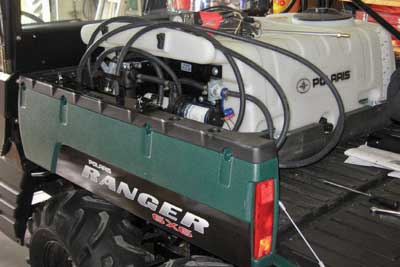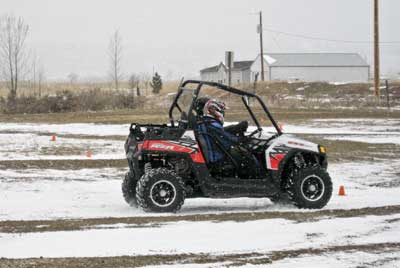Chapter 7—Field Proficiency
Instructor's Notes
- Use the "Field Proficiency" section of the video enhanced PowerPoint presentation.
- Discuss travel arrangements for the field portion of the course.
- Review the driving demonstration area.
- Make sure that the required equipment and PPE are available.
- Use the "UTV Operator Field Evaluation" to document the student's skills.
Chapter Objectives
- Students will demonstrate their skills under the guidance of a qualified instructor/certifier and will be evaluated.
As the instructor, take an active role in training and certifying the students. Demonstrate the proper skills and work with the students to ensure that they gain the skills needed to operate a UTV safely. Make honest and constructive assessments when evaluating each student. Make sure the students understand that further training may be required before they operate a UTV in different regions with different weather and terrain.
Safety should be the number one concern during the field training session. Follow these guidelines to help maintain safety:
- Assign no more than 12 students per instructor for the
field training.
- Prepare a JHA in advance that includes first aid procedures
and emergency evacuation plans. Use the
"Health and Safety Code Handbook" and safety information
in this chapter to help develop the procedures
and plans.
- Conduct a tailgate safety briefing that includes all
aspects of the field proficiency exercises as well as
first aid procedures and emergency evaluation plans.
- Ensure that all students have the appropriate PPE
(figure 54).
- Be aware of the activities taking place in all driving
demonstration areas and make sure that students follow
the correct safety procedures at all times.
- Monitor each student's operating procedures during the driving demonstration. Ensure the students do not drive too fast or recklessly. If problems arise, take corrective action or discontinue the demonstration.

Figure 54—Two students receive final instructions and put on the last of their
PPE before beginning the driving course. Courtesy of Michael Donch.
Setting Up a Driving Demonstration Area
When selecting and developing a driving demonstration area, determine the needs of the students. Work with district or forest staff to locate a site that is suitable, has good access, and is open for UTV use. A parking lot or field site can be used as long as the field site does not have hidden hazards that could tip over a vehicle.
A suggested driving demonstration area "Field Evaluation Driving Course" (appendix D) has been provided. The area needed for this field exercise is a rectangle measuring 150 by 200 feet. The students will drive in a rectangular course measuring 90 by 140 feet. Place orange safety cones every 20 feet along the 140-foot sides of the driving course. Place one orange safety cone along each of the other two sides of the driving course. Finally, place two sets of four cones inside the driving course. Arrange each set of four cones into a circle with a radius of 15 feet. Place these circles 25 feet from the sides of the driving course.
To help create a more realistic field experience, try to tailor your field course to the local conditions or the work your students will experience. For example, if most of your students will operate UTVs on dozer lines or fire lines, try and simulate that environment. You may also want to include or add some maneuvers to your course, such as traversing slopes and crossing obstacles. Keep the maneuvers small and tailor them to your students' skills and abilities.
Many safety issues can be addressed by establishing a secure driving demonstration area, which is identified and managed. No one shall be allowed in the secured driving demonstration area without authorization. A safety zone will be established outside the secure area where students can observe the driving demonstration area. Only the instructor and UTV operator demonstrating his or her skills may be in the driving demonstration area. All other students must remain in the safety zone.
A road or trail guard will be set up on all roads and trails entering and leaving the secured driving demonstration area to prevent members of the public or other employees from entering. Effective communications must exist between the guards and the instructor. One person shall be responsible for maintaining reliable communications with the instructor and students in the safety zone to ensure no one enters the secured driving demonstration area without authorization.
For each field training session, provide the following equipment:
- UTV with a rollover protection system
- Owner's manual and manufacturer's toolkit
- Type IV first aid kit
- Fire extinguisher
- Approved safety container for fuel
If the students (at their workplace) will be operating UTVs loaded with cargo or equipped with industrial equipment, ideally the field training UTV would be loaded or equipped similarly (figure 55). Students need to practice how to properly load cargo. Handling of a UTV changes when it is loaded with cargo or equipped with a particular type of industrial equipment.

Figure 55—UTV being equipped with a pesticide sprayer. Courtesy of Jim
Goodwin.
Each student shall have the following personal protective equipment and clothing (PPE):
- A U.S. Department of Transportation, ANSI Z90.1, or
Snell Memorial Foundation-approved full- or threequarter
face motorcycle helmet with chinstrap.
- Gloves.
- Long pants.
- Long-sleeved shirt, jersey, or jacket.
- Appropriate footwear.
- Eye protection (safety glasses, goggles, or sunglasses). Eye protection is not required for UTVs with original equipment manufacturer windshields.
While in the field, demonstrate how to properly perform a preride inspection. A student may perform the demonstration as an interactive exercise. Any of the student's errors or omissions must be corrected.
Review and demonstrate each of the skills the students need to learn.
- Identify appropriate PPE and how to wear it properly.
- Show them how to load and unload a UTV onto a trailer.
- Demonstrate the proper techniques for transporting hazardous materials.
Then use the driving course to review safe operating practices, such as loading cargo, staring up, braking, turning, and parking. If you add maneuvers to the course, such as traversing slopes, go over the proper techniques for completing these tasks. A suggested route through the course is:
- Start at point A.
- Turn right at point B.
- Turn right at point C.
- Turn right at point D.
- Complete a figure eight around the circles.
- Turn right at point E.
When the beginning of the course is reached, turn around and go through the course in the opposite direction. It will be beneficial for the students if they drive one half of the course by themselves and the other half with a passenger to see how the UTV handles differently.
Now, let the students practice (figures 56a and b) but keep a careful eye on them and take immediate action when mistakes are observed.
 |
 |
| Figure 56a and b—Students practice on the driving course. Courtesy of Michael Donch. | |
Use the "UTV Operator Field Evaluation" (appendix E) to evaluate each student's skills once they have had sufficient practice. For each skill, have the student perform the task and give the student a rating of complete or incomplete. If the student performs poorly, document the additional training needed on the "UTV Operator Field Evaluation" and restrict the student's operational activities to specific locations, regions, or terrain.
Once the students have completed the course, remind them they are novice operators. They need to take it slow until they build their experience and skill level on the machines.

